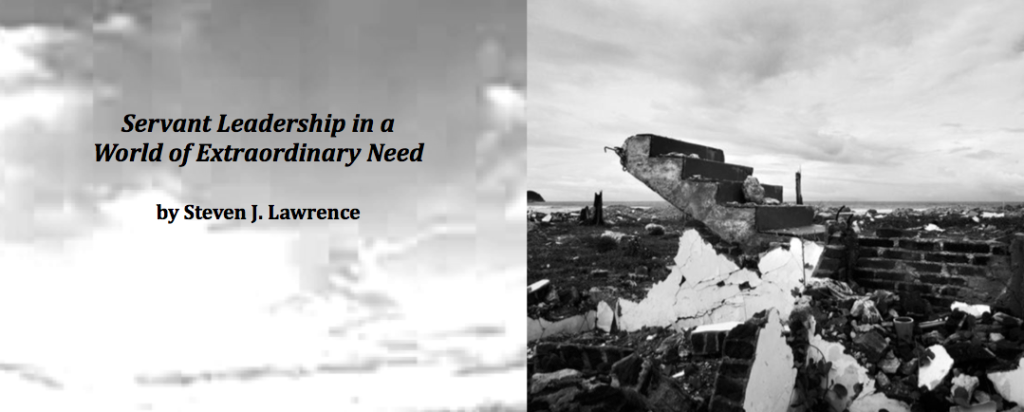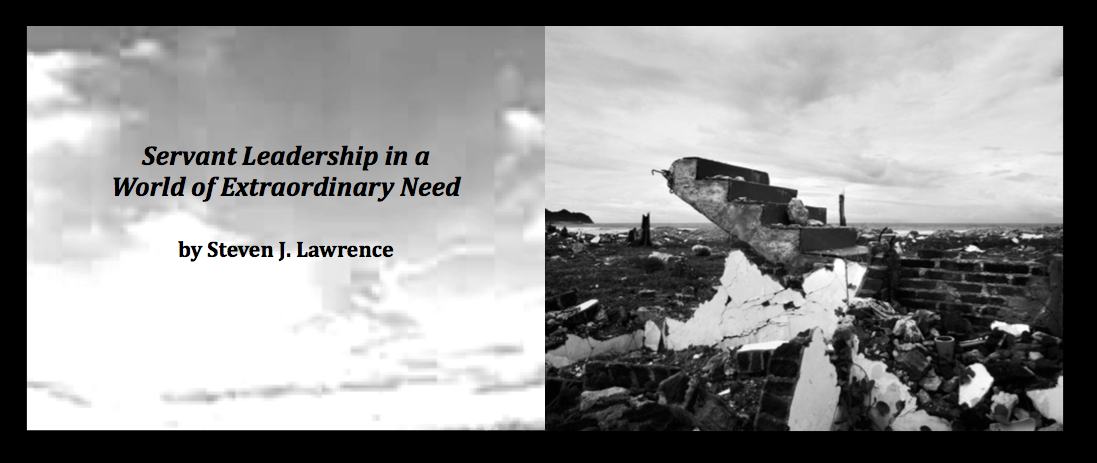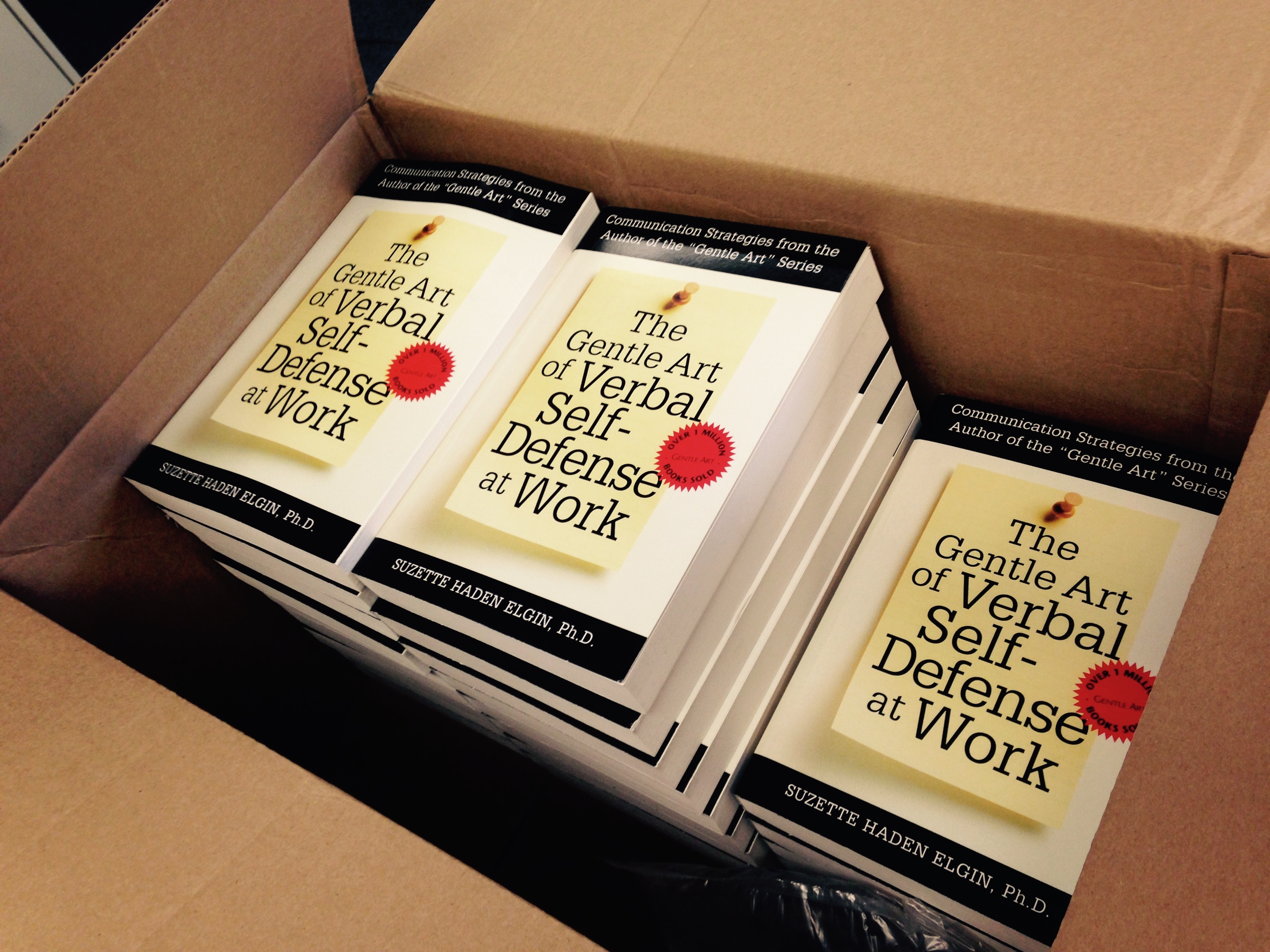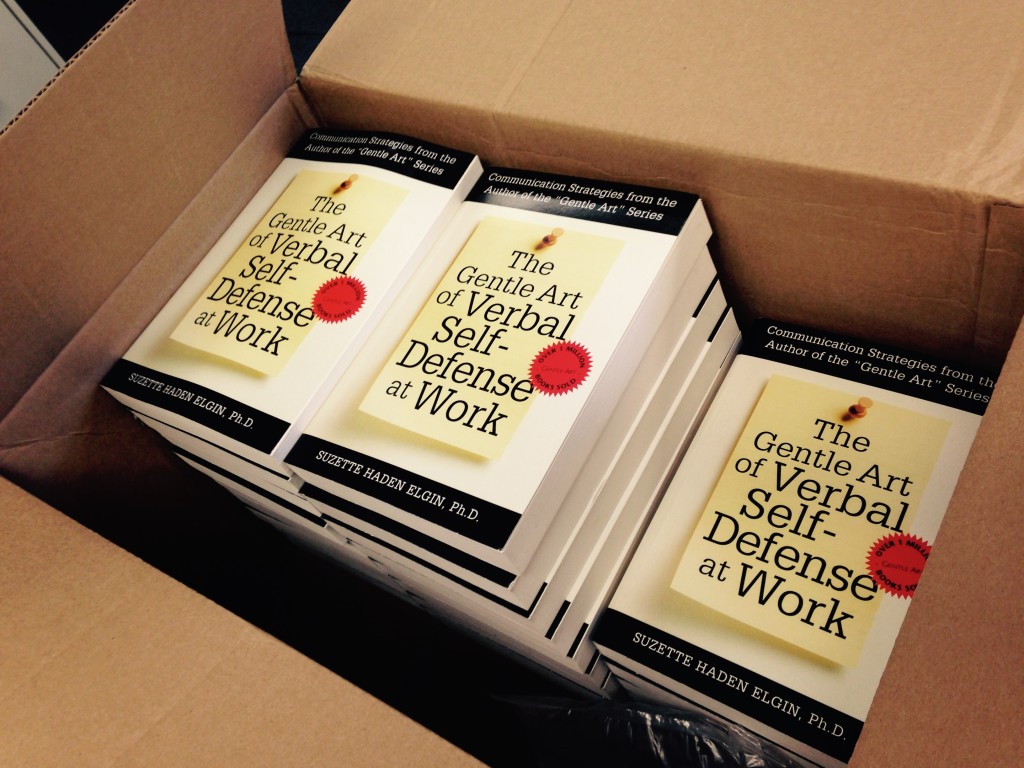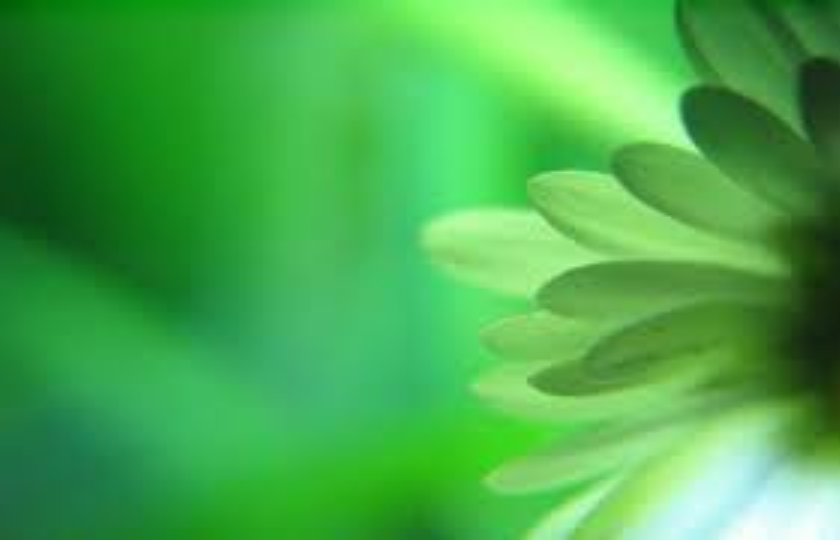*I’m re-posting this essay in its entirety. It was first published in 2014.
In early October, I was walking with a friend. We were discussing the topic of compassion, and he said something striking.
“Compassion is not boundless. To be effective, it needs to be channeled into a specific locality or sphere in which you have the influence to make at least a part of the world a better place.”
This quote is a good starting place for introducing the concept of Servant Leadership, because the sphere of influence and the compassionate vision of a Servant Leader are broad indeed.
Robert K. Greenleaf, who founded the “Center for Applied Ethics” in 1964, coined the term Servant leadership. After he died in 1990, the name of his organization was changed to the Greenleaf Center for Servant Leadership. At the present time, the Servant Leadership movement representing the ideas of Robert Greenleaf is under the stewardship of Larry Spears.
What is Servant Leadership?
Greenleaf spent more than 40 years after early retirement researching management, leadership, education, and organizational culture. Over time, he came to the conclusion that the institutions in this country -both public and private- are suffering from a “crisis in leadership.”
In the Essay that started it all, Servant as Leader, Greenleaf introduces a vision of leadership in which leaders see themselves as servants first and leaders second. Leadership is viewed as an instrument of serving the greater good, not as an end itself, and the search for and acquisition of power or influence is always subsumed into the overarching desire to be of service.
Servant Leaders are fundamentally about people and define the stakeholders in their sphere of influence quite broadly, including colleagues, subordinates, and boards of directors/trustees, clients and even the world at large. They place the needs of their people as primary and will not sacrifice the needs of the organization they lead in the service of furthering their own careers.
Before I elaborate on the conceptual framework and human values around Servant Leadership, I want to say a few words about the title I chose for this section. The wording of the title was borrowed from an article by legal scholar David Yamada, the author of the Healthy Workplace Bill. His title is “The social responsibilities of intellectuals at a time of extraordinary need.” This article is worth a read, as are all of David’s writings that I have been introduced to.
Though I did not know David personally when I first drafted the original version of this essay, I was fortunate to meet him at a healthy workplace brainstorming conference he recently organized at Suffolk Law University. For this gathering in the fall of 2015, David invited six professionals from various fields to present works-in-progress for feedback from the other presenters and from others who attended the conference. As one of the presenters, my contribution included the importance of promoting positive models for organizational leadership and strategies for neutralizing covert aggression in the workplace.
Interestingly, David Yamada has been recognized in recent months as one of the 30th most influential organizational/industrial psychologists alive in the world. The only thing surprising about this is the fact that David -a legal scholar and professor at Suffolk Law University- is not, in fact, a formal organizational psychologist. Yet, the honor so bestowed is apt indeed. A lifetime of study, investigation, and development of insights in the recognition of the patterns of organizational behavior that adversely impact the micro and macro levels of society is worthy not only of recognition but of a movement.
At the present time, David Yamada is one of my favorite authors in the areas of human dignity, workplace ethics and social responsibility. It is with his encouragement that I have been putting out more writings on Servant Leadership.
Why We Will Always Need Leadership
The world has always been in extraordinary need, and that’s not going to change. We live on a planet with natural laws, including weather patterns, ecosystems, and the presence of a large variety of organisms all competing with one another for survival. The common reality faced by all organisms is the inevitability of death and the desire to continue on with living until that inevitable event happens.
For individual human beings, survival includes the need to be safe, accepted, nourished and happy as defined by each individual. A significant portion of our survival is addressed by the development of society, which includes the development of local, national and international laws and armed services which protect us, physical infrastructures that transport and house us, agricultural systems that feed us, medical services that heal us, and institutions that organize, educate and serve us.
So, we can’t get away from the fact that human beings need organizations, both small and large to take care of our world. We are continually organizing resources, building/managing institutions that curate and distribute those resources, and placing people in leadership positions to provide direction in the management of those resources. Leadership is also needed to facilitate the ongoing development and management of abstract resources like scientific knowledge, political and economic theory, moral frameworks and religious/spiritual systems.
Like it or not, we will always need organizations, which means that we will always need leaders.
Put in the plainest possible terms, human beings are called upon to be stewards of our world, and this means we are sometimes called upon to take initiative and to step out in front of others to influence the direction of that stewardship. In the best possible scenario, those of us who choose to step out possess the fundamental asset that best qualifies us to ask others to place their trust in us: empathy.
In optimal circumstances, people in leadership positions care about people and act in good faith to actively serve them. But, even a cursory glance at the leadership landscape reveals to us that many leaders operate out of narcissism, ego-centric agendas, and short-term gains at the expense of others, and frequently act with a destructive, even sadistic need to triumph over people.
The world is burning, because we fail to recognize the traits of narcissistic leadership and continue to promote narcissistic leaders into positions of power throughout the entire maze of society’s institutions. We need to learn how to spot these people before elevating them. But, more importantly, we need to learn how to spot those we can trust to take responsible stewardship of our resources.
It’s time for us to identify the traits we can expect from genuinely caring leaders, and we need to promote the understanding of those traits far and wide, if we hope to adequately attend to the extraordinary needs of the world we share.
We can start by examining the characteristics and behaviors of Servant Leaders.
A Servant Leader’s Worldview
I want to repeat the quote from my friend to illuminate an important aspect of a Servant Leader’s worldview.
“Compassion is not boundless. To be effective, it needs to be channeled into a specific locality or sphere in which you have the influence to make at least a part of the world a better place.”
I believe he meant to say that compassionate action is not boundless. Maturity informs us that no single individual, ideology or group is going to “save the world”, and experience has proven the disastrous results for those who have tried. An imperial attitude of domination -however well meaning- will always meet with fierce resistance, and when greatness succumbs to grandiosity, a hero always burns.
But empathy and compassion can indeed be boundless. The modern-day adage “Think globally, Act Locally” sums this up pretty well. Our actions have an impact on the vast web of inter-related relationships and systems throughout the world, and those of us who understand and act in accordance with this understanding naturally develop over time a sense of kinship and empathy with people -and even animals- that we don’t know personally. And, when people with this worldview act, it is always with the understanding of the impact of that action on the world. They act locally with a vast global attitude.
It is beyond the scope of this essay to delve into how a person comes to the fulcrum of development in which she genuinely empathizes with literally billions of others. It also needs to be pointed out that the paradigm of perfect, altruistic enlightenment in a single individual can be harmful because it’s an impossible ideal.
Servant Leaders are not and can never be perfect, altruistic flawless human beings. But, they can, and often do practice the principles that inform their greatest moments of clarity and good will. In those moments, the servant who has chosen to lead recognizes with crystal clarity the responsibility he has to take care of the present. He recognizes that taking care of the present can help to take care of the future for people he will never even meet.
This is most certainly a boundlessly compassionate worldview, and it matters a great deal in a world of extraordinary need.
But, Servant Leadership should not be viewed as a station of completed development or evolution. Rather, it should be viewed as a cultivated attitude and as a practice. Part of that practice includes the commitment to humility, listening to others, and to remain open to new knowledge and learning. Although the framework for Servant Leadership is relatively simple, Greenleaf identified a number of observable qualities in servants who choose to lead.
Ten Principles of Servant Leadership
Robert Greenleaf developed a list of ten principles that guide the Servant Leader. The principles I have outlined below are drawn from the literature, but the descriptions are in my own words. For a more in-depth look at the Ten Principles, I recommend the writings of Larry S. Spears, who currently leads the Robert Greenleaf Center for Servant Leadership.
Listening – A servant leader truly listens to people, not just to understand but to address needs as they arise and are communicated. Surprisingly, humility is not listed as one of the top characteristics of Servant Leadership, but can be included here as the close cousin to listening. Without humility, the servant leader can never learn and certainly has no reason to listen.
Empathy – Compassionate leaders care about people they are working with, the people served by the enterprise they are leading, and the community in which their organization operates, including the larger world community.
Healing – A leader who cares about people is committed to wholeness and healing. If she recognizes a deficiency or need in a person, she works to find ways for that person to heal and to become more complete. This is not an annoying distraction from the organizational mission or business bottom line, but an important part of building and sustaining a team of mutually trusting partners.
Awareness – A person who has formal authority in any situation, including a workplace, group project or national organization has enormous power to make a difference. This is why it’s key to elevate people to leadership positions who have a sophisticated awareness about many things. Awareness of the impact of their work, the patterns of behavior on their team, and the importance of gathering information from multiple sources to ensure the best way forward.
Persuasion – Leaders who care about people do not cause harm. They recognize that forcing others to act or to take a position is a harmful action, and thus, seek to persuade people with reasoned argument and an appeal to the mission. They are not coercive.
Conceptualization – Like Transformational Leaders, Servant Leaders provide a compelling framework for the work they are doing in concert with others. They take care to build concepts that appeal to the hearts and minds of people and that promote values that directly relate to the mission.
Foresight – Socially responsible leaders look ahead to potential fallout and beneficial outcomes of their actions and the actions of the enterprises they lead. They contemplate not only the ways in which their organization might benefit from specific actions but how decisions and actions impact their people and the community around them. In other words, they take the long view.
Stewardship – The word stewardship has become a popular piece of jargon, but the principle is profound and important. Too many stories are coming out that tell the tale of a CEO who comes on board at the eleventh hour of a business and runs it into the ground before walking away with millions of dollars and a large workforce unemployed and destitute. A Servant Leader comes on board to rescue the business or to work with people to find ways to close the business that can benefit the largest amount of people as possible. She takes seriously her responsibility to steward the enterprise in a way that helps the micro-community of the business or organization and the macro-community in which the enterprise operates.
Commitment to the Growth of People – This is a big one. Regardless of the original mission or reason that people come together, a leader who wishes to serve the common good is first and foremost committed to growing as a person, allowing others to help her grow as a person, and helping other people to grow. Whether coming together to record a music album, making a full-length feature film, running a public school, or building a legal case, the people with formal authority to set the tone for the community of people always have their eye on the common good as the greater, over-arching purpose. In this category, stewardship takes on a broader meaning. What is ultimately and always stewarded is the building of a better world because people have the chance to grow.
Building Community – All of the above principles act in concert to build a positive community. Because of the principles of listening, awareness, persuasion, stewardship, healing, awareness and empathy, there is little room for a “cult of personality.” Furthermore, if the conceptualization of the community’s mission is clear and includes foresight, there will be a built-in understanding of the ways in which authoritarianism and “cultishness” can be avoided. This is partly related to a commitment to the growth of people. People can only grow if a community isn’t all about the “leader” and if there’s room for feedback and development of the leader himself. Ultimately, this kind of community is made up of Servant Leaders, all of whom take turns to step into the role of stewarding the community’s process at one time or another.
Criticism of Servant Leadership
Servant Leadership can also be called socially responsible leadership, caring leadership, or even steward leadership. Boiled down to its essence, this is a leadership philosophy that makes caring about people the most important thing.
It would be difficult to argue that leaders should not care about people. But, while most critics would agree that caring leaders are needed in the world, some have argued that this leadership style subtly and deceptively contains a gender bias, a patriarchal stance, and a strong representation of the myths and moralities in the Judeo-Christian tradition. Some have even referred to it not as a leadership philosophy but a leadership theology pointing out what they consider a strong religiosity and the occasional reference to the word “spiritual” in some of the literature.
Although Servant Leadership in recent years has steadily gained recognition as a viable model for positive, ethical and efficient leadership among leadership experts and social scientists such as Margaret Wheatley and Peter Senge from the MIT Sloane School of Management, it is by no means a universally accepted paradigm.
The main criticism is that this model of leadership is paradoxically both ambiguous and over-prescriptive, as this framework a) doesn’t catalogue empirically observable behaviors and b) doesn’t take into account the diverse perspectives and insights that arise within a community, instead relying on a predetermined ideology. This, according to critics, is counterintuitive to the post-modern age of facilitative approaches to decision-making in which all stakeholders participate and retain their own autonomy culturally and ideologically.
I can appreciate some of these criticisms, and the fact that Robert Greenleaf was a white, male Christian easily opens this model up to being discredited. At some point, I hope to write a response to an essay criticizing Servant Leadership from a feminist perspective. In that piece, I will respond to the microanalysis and socio-cultural deconstruction of the assumptions, aims, language and contradictions inherent in this leadership philosophy.
For now, I just want to make one point.
Stewardship is an attitude of wanting to take care of our world. A person who has an attitude of wanting to help (be of service) will identify problems and work to find ways to solve those problems. If that person winds up in a position of formal authority, he is likely to want to develop people on his team or in his organization. This means he will be able to notice frustration in those who feel they lack a voice. He will most likely want to remove that frustration or help to neutralize it by adopting a participative approach in which that person will have a voice. And the organization will be all the better for it, because the information gleaned from the participative process will most likely lead to more informed decisions. This will help the enterprise and help sustain long-term relationships within the community, team or organization.
So, the assumption that Servant Leadership necessarily precludes an egalitarian approach to decisions is just that. An assumption. And, an unexamined one, at that.
The key is empathy. When a person of formal authority genuinely cares about people and has a compassionate attitude, he will use whatever leadership models and strategies available to him that can get the best results and maximize the benefits for the largest amount of people. Sometimes, this will be participative, and sometimes it might be transformational. Leaders who serve (or servants who lead) are the ultimate situational leaders because they are aware and emotionally intelligent enough to understand the full potential of these models and strategies.
We can go around in circles, critically analyzing and making sure never to allow any one theory, individual, group or position to dominate (a major preoccupation that postmodernists/deconstructionists have), or we can be honest about the fact that leaders will always be around and that we need to promote at the very least the fundamental value of having a heart.
Heart matters in a world of extraordinary need.
